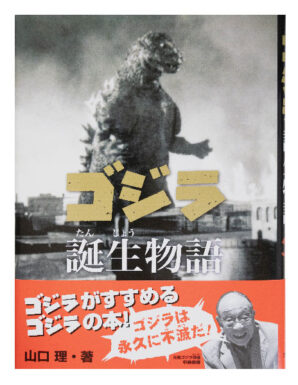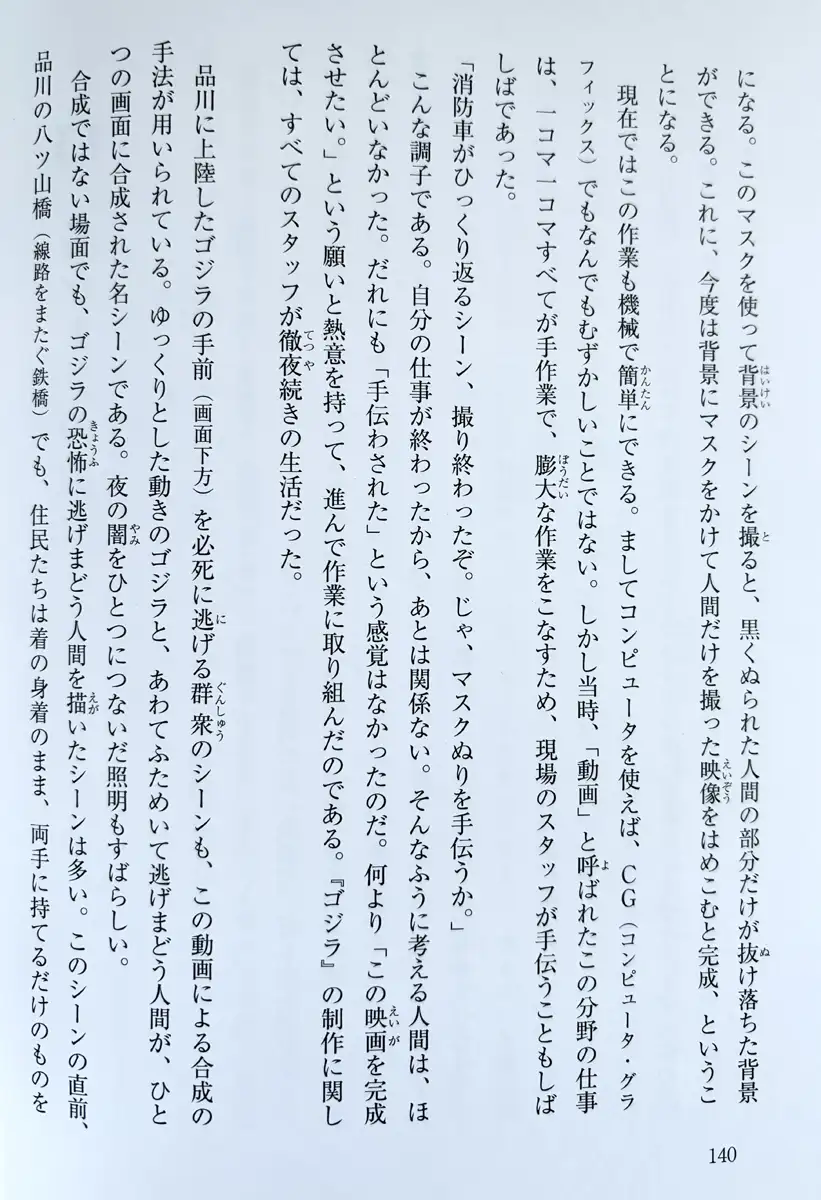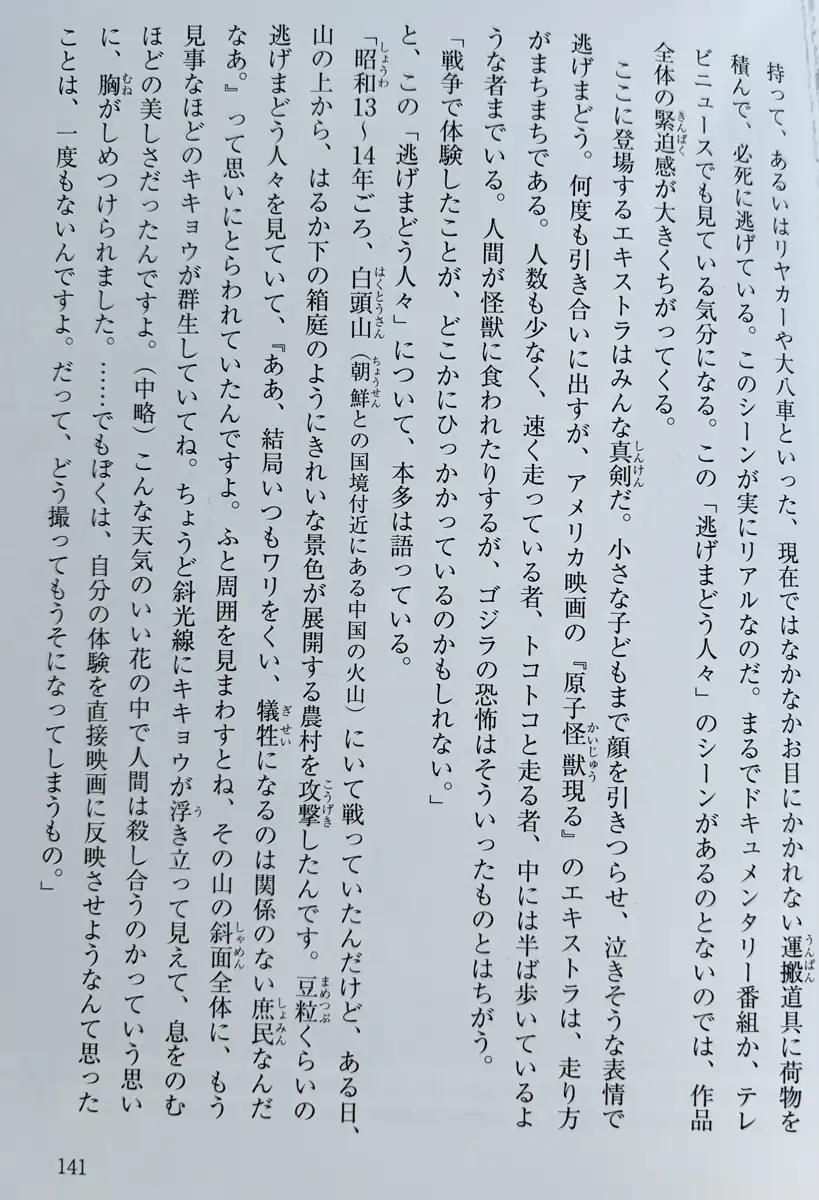4.18.2024
The Story of Godzilla’s Birth – Pt 63


P 140
このマスクを使って背景のシーンを撮ると、黒くぬられた人間の部分だけが抜け落ちた背景ができる。これに、今度は背景にマスクをかけて人間だけを撮った映像をはめこむと完成、ということになる。
If you take a picture of a background scene using this mask, you will get a background with only the human parts painted in black missing. Next, add a video of only humans with a mask in the background, and the work is complete.
現在ではこの作業も機械で簡単にできる。ましてコンピュータを使えば、CG(コンピュータ・グラフィックス)でもなんでもむずかしいことではない。しかし当時、「動画」と呼ばれたこの分野の仕事は、一コマーコマすべてが手作業で、膨大な作業をこなすため、現場のスタッフが手伝うこともしばしばであった。
Nowadays, this work can easily be done by machines. Moreover, if you use a computer, CG (computer graphics) is not difficult. However, in this field of video, which was then called “video,” every frame was done by hand, and because it involved a huge amount of work, on-site staff were often required to help.
「消防車がひっくり返るシーン、撮り終わったぞ。じゃ、マスクぬりを手伝うか。」
“We’ve finished filming the scene where the fire truck flips over. Now, how about you help me color the mask?”
こんな調子である。自分の仕事が終わったから、あとは関係ない。そんなふうに考える人間は、ほとんどいなかった。だれにも「手伝わされた」という感覚はなかったのだ。何より「この映画を完成させたい。」という願いと熱意を持って、進んで作業に取り組んだのである。『ゴジラ』の制作に関しては、すべてのスタッフが徹夜続きの生活だった。
This is how things are going. My job is done, so the rest doesn’t matter. Very few people thought like that. I never felt like I was being “helped” by anyone. More than anything, he was willing to work on the project with a desire and enthusiasm that he wanted to complete the film. All the staff members stayed up all night during the production of “Godzilla.”
品川に上陸したゴジラの手前(画面下方)を必死に逃げる群衆のシーンも、この動画による合成の手法が用いられている。ゆっくりとした動きのゴジラと、あわてふためいて逃げまどう人間が、ひとつの画面に合成された名シーンである。夜の闇をひとつにつないだ照明もすばらしい。
This video compositing method was also used in the scene of the crowd desperately running away in front of Godzilla (at the bottom of the screen) when it landed in Shinagawa. This is a famous scene in which the slow-moving Godzilla and the panicking humans running away are combined into one screen. The lighting that connects the darkness of the night is also wonderful.
合成ではない場面でも、ゴジラの恐怖に逃げまどう人間を描いたシーンは多い。このシーンの直前、品川の八ツ山橋(線路をまたぐ鉄橋)でも、住民たちは着の身着のまま、両手に持てるだけのものを
Even in scenes that are not composites, there are many scenes depicting humans fleeing in fear of Godzilla. Just before this scene, at Shinagawa’s Yatsuyama Bridge (an iron bridge that crosses the railroad tracks), residents were wearing only the clothes they were wearing and carrying as much as they could hold in both hands.

P 141
持って、あるいはリヤカーや大八車といった、現在ではなかなかお目にかかれない運搬道具に荷物を積んで、必死に逃げている。このシーンが実にリアルなのだ。まるでドキュメンタリー番組か、テレビニュースでも見ている気分になる。この「逃げまどう人々」のシーンがあるのとないのでは、作品全体の緊迫感が大きくちがってくる。
They flee desperately, either carrying their belongings with them or loading their belongings onto carts, large carts, and other transport equipment that are rarely seen these days. This scene is so real. It feels like I’m watching a documentary or TV news. The sense of urgency of the entire work is greatly different depending on whether or not this scene of “people running away” is included.
ここに登場するエキストラはみんな真剣だ。小さな子どもまで顔を引きつらせ、泣きそうな表情で逃げまどう。何度も引き合いに出すが、アメリカ映画の『原子怪獣現る』のエキストラは、走り方がまちまちである。人数も少なく、速く走っている者、トコトコと走る者、中には半ば歩いているような者までいる。人間が怪獣に食われたりするが、ゴジラの恐怖はそういったものとはちがう。「戦争で体験したことが、どこかにひっかかっているのかもしれない。」と、この「逃げまどう人々」について、本多は語っている。
All the extras that appear here are serious. Even small children run away, their faces drawn and looking like they’re about to cry. As I’ve mentioned many times, the extras in the American movie “The Beast from 20,000 Fathoms” vary in their performance. There were only a few people, some running fast, some running slowly, and some even half walking. Humans are eaten by monsters, but Godzilla’s fear is different from that. “Perhaps what they experienced in the war has stuck with them somewhere,” Honda says of these “people fleeing.”
「昭和13~14年ごろ、白頭山(朝鮮との国境付近にある中国の火山)にいて戦っていたんだけど、ある日、させい山の上から、はるか下の箱庭のようにきれいな景色が展開する農村を攻撃したんです。豆粒くらいの逃げまどう人々を見ていて、『ああ、結局いつもワリをくい、犠牲になるのは関係のない庶民なんだなあ。』って思いにとらわれていたんですよ。ふと周囲を見まわすとね、その山の斜面全体に、もう見事なほどのキキョウが群生していてね。ちょうど斜光線にキキョウが浮き立って見えて、息をのむほどの美しさだったんですよ。(中略)こんな天気のいい花の中で人間は殺し合うのかっていう思いに、胸がしめつけられました。・・・・・・でもぼくは、自分の体験を直接映画に反映させようなんて思ったことは、一度もないんですよ。だって、どう撮ってもうそになってしまうもの。」
“Around 1939 or 1940, I was fighting on Mt. Baekdu (a Chinese volcano near the border with Korea), and one day, from the top of Mt. Sei, I saw a rural village with a beautiful view that looked like a miniature garden far below. When I saw pea-sized people fleeing, I thought to myself, “Ah, in the end, it’s always the ordinary people who have nothing to do with it and end up getting the better of me.” I was obsessed with this thought. When I suddenly looked around, I saw that there was a beautiful cluster of bellflowers growing all over the slope of that mountain. The bellflowers were just visible in the oblique rays of light, and it was breathtakingly beautiful. (Omitted) My heart tightened as I wondered if people would kill each other in such a beautiful flower. …But I’ve never thought about directly reflecting my own experiences in a movie. After all, no matter how you photograph it, it turns out to be a lie.”